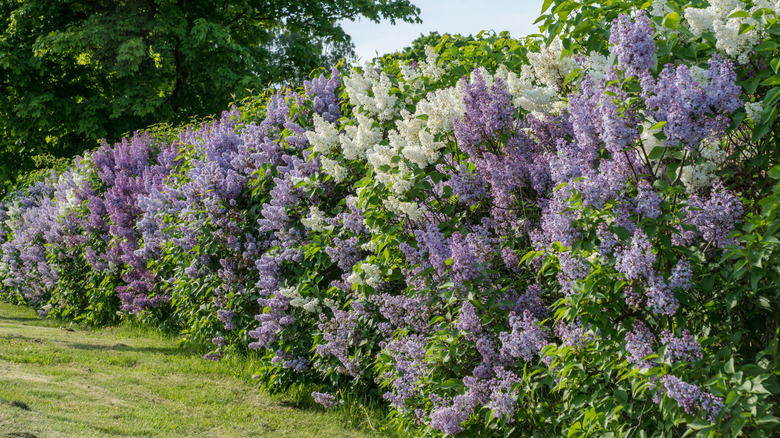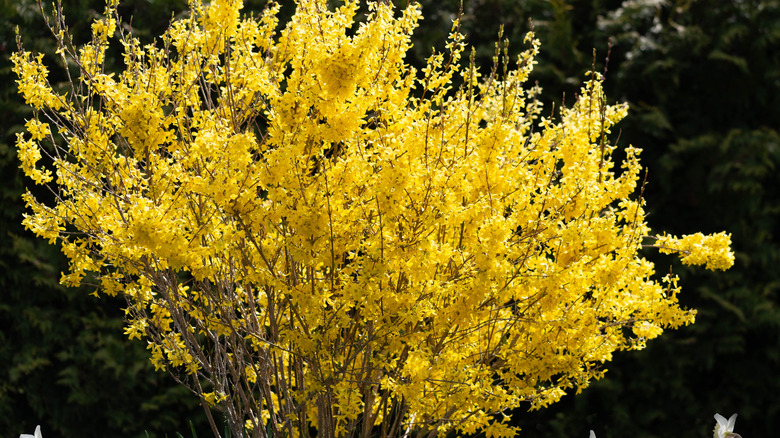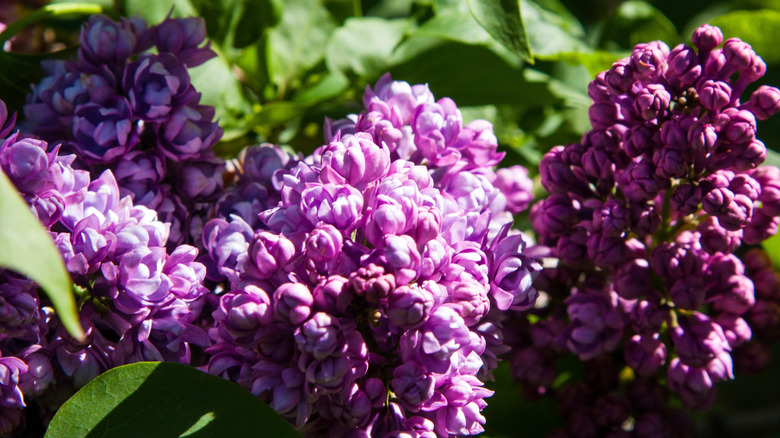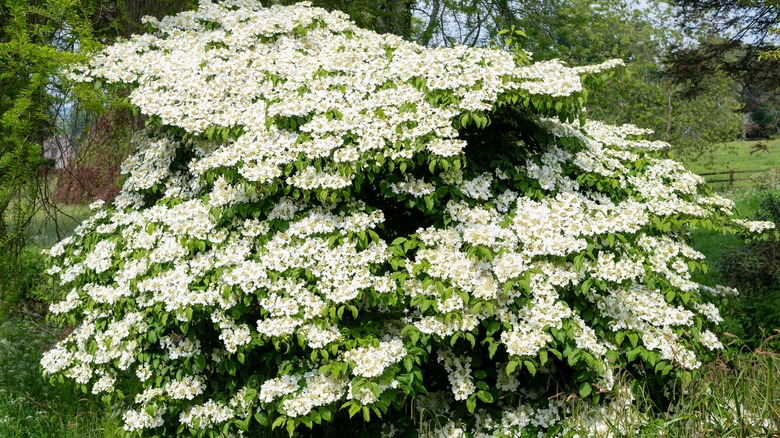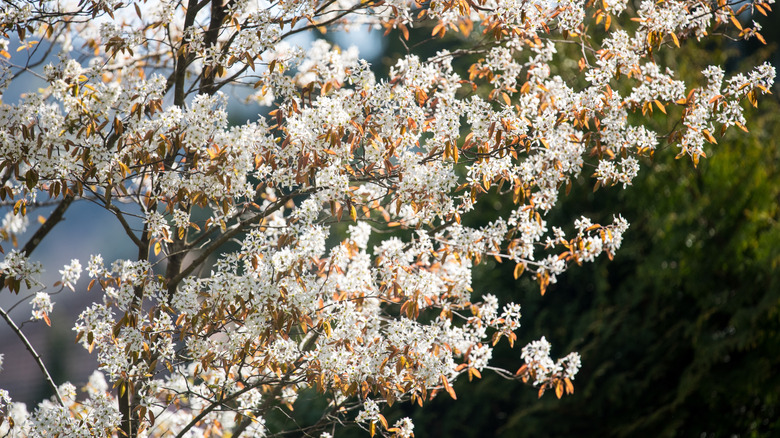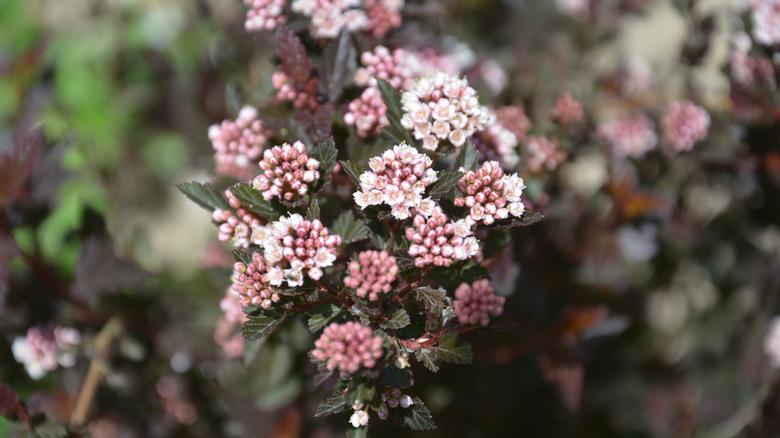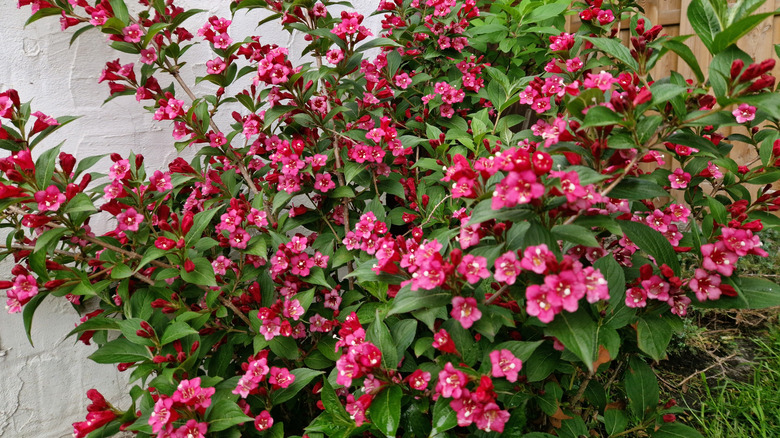7 Shrubs To Plant In October For A Flourishing Spring Landscape
Fall gardening is all about looking forward. Whether you're planting flower bulbs that will bloom in spring or scattering wildflower seeds, autumn is a season of harvest and of preparation. October is a perfect time to plant any shrubs as well, with a little work going a long way towards creating a stunning spring landscape.
The brisk fall months are ideal for planting many types of bushes and shrubs. The weather is finally cooling down enough that the plants won't struggle with heat stress or drought while working to get established, but they still have time to develop their roots before temperatures get too cold. There's generally no need to fertilize at the time of planting, either. Just make sure to dig a large enough hole, with the width about twice the size of the root ball and the depth the same size as the root ball.
A layer of mulch will help provide your new plants with protection from temperature and moisture extremes. And don't forget to water your new shrubs when necessary. While plants generally need less water in winter, that doesn't necessarily mean that they don't need any water at all — especially for newer plants that are still getting established. With proper care, your autumn efforts will result in a stunning spring garden.
Forsythias for a sunnier spring
The stunning yellow blooms of forsythias are beloved as an early sign of spring. Native to Europe and parts of eastern Asia, forsythias are hardy in USDA Hardiness Zones 3b through 8. Autumn is a great time to plant these beauties. Just make sure to plant them in a sunny spot. While they can handle a range of soil conditions, they grow best in well-draining soil. Depending on the specific cultivar, forsythias can range in size from just 24 inches tall and wide to around 10 feet tall and 12 feet wide.
Azaleas give you reliably bold color
Azaleas are an ideal way to add a riot of color to your spring and early summer landscape, and fall is the perfect time to plant them. With blooms that can range from reds and whites to oranges and even purples, azaleas are a must grow for gardeners in USDA hardiness zones 5 through 9. Part of the Rhododendron genus, azaleas thrive in part sun locations with acidic and well-draining soil. Most cultivars range in size from around 10 feet tall to only around 3 feet.
Lilacs add delightful aromas to the garden
Lilacs (Syringa spp.) are an iconic scent of spring, thanks to their beautiful and fragrant flowers. While pale purple blooms are the most well known, lilacs can also have white, or even yellow petals. Hardy in zones 3 through 8 lilacs grow best in full sun and can tolerate a range of soil types as long as they are well draining. While common lilacs grow to around 20 feet tall, smaller species like dwarf Korean lilacs rarely grow past 4 feet. Fall is the ideal time to plant these beautiful shrubs.
Native viburnums provide year-round interest
Another shrub to plant in autumn is viburnum, a genus known for beautiful white flowers. While some species like the linden viburnum are invasive in North America, there are plenty of native viburnums to choose from. One of the most beautiful is the American cranberrybush viburnum (Viburnum trilobum). It doesn't just have beautiful flowers in mid-spring, it also boasts bright red berries during fall and winter. Hardy in zones 2 through 7, the American cranberrybush viburnum flourishes in moist soil and full to part sun. It grows about 12 feet tall, though smaller cultivars exist.
Serviceberries are easy to grow
Another fantastic shrub to plant around October is a serviceberry (Amelanchier spp.) bush. Most serviceberries are native to North America, and depending on the species, they can be hardy everywhere from zone 2 to zone 8. In addition to its pretty white flowers in spring, serviceberries also have edible fruit. This easy-growing fruit tree is also a huge hit with birds and pollinators. Serviceberries thrive in moist, well-draining soil and can tolerate everything from full sun to full shade.
Ninebarks have peeling bark and pink-white blossoms
Another North American native to plant in October is the ninebark (Physocarpus opulifolius), known for its exfoliating bark pattern. Hardy in zones 2 through 8, ninebarks boast clusters of blooms in mid-spring through early summer. While they generally grow about 8 feet tall and wide, smaller cultivars also exist. Be sure to plant your ninebark in full to part sun, but don't worry too much about soil conditions as they can thrive in many soil types and textures. Ninebarks are also a great way to attract more birds and bees to your garden.
Weigelas will bring in more pollinators
Weigelas are another stunning shrub to plant in your garden in fall to ensure plenty of colorful blooms come springtime. Their pink, red, or white flowers are a hit with hummingbirds and butterflies, and their deer resistance makes them perfect to put in unfenced parts of your landscape. Hardy in zones 4 through 8, weigelas thrive in full to part sun and are tolerant various soils. Just be sure not to prune your weigela bushes too late in the season, as they bloom on old wood.
